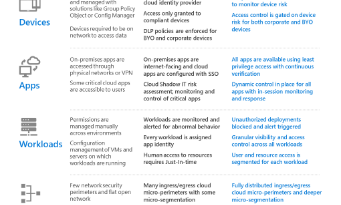Data center networking trends to watch for 2023

Hybrid and multicloud initiatives will continue to shape enterprise IT in 2023, and the impact on data-center networking will be felt across key areas including security, management, and operations. Network teams are investing in technologies such as SD-WAN and SASE, expanding automation initiatives, and focusing on skills development as more workloads and applications span cloud environments.
“The most important core trend in data centers is the recognition that the hybrid cloud model – which combines current transaction processing and database activities with a cloud-hosted front-end element for the user interface – is the model that will dominate over time,” said Tom Nolle, president of CIMI Corp. and a Network World columnist. The industry is seeing a slow modernization of data center applications to support the hybrid-cloud model, Nolle says, “and included in that is greater componentization of those applications, a larger amount of horizontal traffic, and a greater need to manage security within the hosted parts of the application.”
As hybrid initiatives advance, organizations are instituting new guidelines on what workloads can move to a public cloud and which need to move back on-prem, says Thomas Scheibe, vice president, product management, with Cisco’s cloud networking group.
“IT and corporate finance organizations will devote increased focus on capturing the lifecycle cost of applications, as more organizations are grappling with growing bills from their cloud providers,” Scheibe says. “This will create more demand toward multi-cloud networking and hybrid cloud solutions to give companies more options and flexibility.”
The appeal of “lift and shift,” will start to sour, says Mike Bushong, vice president, cloud-ready data center, with Juniper Networks. “A lot of companies moved to the cloud with the premise that costs would be cheaper. They engaged consulting companies or partners to help them lift their existing applications and move them to the cloud,” he said.
Hybrid cloud is the future, Bushong says, but he doesn’t expect to see applications shifting dynamically from on-prem to cloud and back. “Applications that are not cloud-native but are still needed likely will stay where they are. New applications will be built with a specific hosting location in mind. And they will largely stay where they are,” he said.
Still, “the move to the cloud will have given these companies a taste of cloud operations, and that will be enough to trigger a general adoption of cloud-like workflows and interfaces in on-prem infrastructure,” Bushong says.
Indeed, it’s all about the workflows and how to best handle them over the network, experts say.
“Traditional enterprises aren’t necessarily building new data centers anymore. But more increasingly, they’re deploying centers of data,” says John Gray, Aruba’s data center marketing lead. Data-center customers are partnering with colocation providers and cloud service providers, and they’re being drawn in by the consumption models these providers can offer, as well as the flexibility to choose performance levels based on different workloads and use cases, he says.
Security inside and outside the data center
Greater use of cloud services and collocation facilities is in turn contributing to growth in deployments of SD-WAN and secure access service edge (SASE) technologies to secure access to these resources.
“Pushing both customer/partner and worker access to applications through a cloud front-end means that you need to push security and VPN on-ramp functions into the cloud, which means SASE/SD-WAN. This means that SD-WAN likely evolves to become more important than MPLS VPNs,” CIMI’s Nolle says.
SASE, which consolidates SD-WAN with a suite of security services, is gaining the attention of organizations that need to safely accommodate an expanding edge that includes not only public clouds but also branch offices, remote workers and IoT networks.
“3Q 2022 was the seventh consecutive quarter of year-over-year SASE revenue growth topping 25 percent, which signals the importance enterprises are placing on SASE,” said Mauricio Sanchez, research director, network security, and SASE and SD-WAN, at Dell’Oro Group. “Unlike some other network security markets we track, we expect the high investment priority will continue and lead to the SASE market eclipsing $8 billion in 2023.”
Research firm Gartner is anticipating an even bigger market – it estimates that worldwide SASE spending will hit $9.2 billion in 2023, a 39% increase from 2022.
“The adoption of cloud and edge computing and work-from-anywhere initiatives has radically shifted access requirements,” Gartner wrote in a recent report. “For most organizations, there are now more users, devices, applications, services, and data located outside of an enterprise than inside. Attempts to use traditional perimeter-based approaches to securing anywhere, anytime access have resulted in a patchwork of vendors, policies, consoles and complex traffic routing, creating complexity for security administrators and users.”
Security inside the data center is also undergoing changes. In particular, many enterprises are considering the advantages of network fabric technology. A network fabric typically uses a mesh of connections between access points, switches, and routers that transports data to its destination.
“There is way more east-west traffic in the data center today, and fabric technology is in a unique position where it can be that single source of truth, because all the traffic traverses that infrastructure at the access layer or the leaf and spine. And a lot of customers like the idea of a fabric because it has the visibility to gather all that data-center telemetry and use it for specific security functions that they have a need to monitor,” says Aruba’s Gray.
On the management front, enterprises can fortify their hybrid environments and streamline security management through greater automation and abstraction.
“If security teams can implement tools that let them use a common framework for security management across multiple clouds, they can mitigate the largest risks of misconfiguration and operational mistakes,” stated Cisco in its recent Global Hybrid Cloud Trends report.
Automation key to hybrid operations
In the big picture, infrastructure automation is critical to operating at cloud scale and efficiency. In its research, Cisco found 49% of surveyed organizations have deployed automation.
“This is an area where there has traditionally been underinvestment. When compared with overall cloud use, there is a striking difference in the adoption of infrastructure automation. Of those organizations with only a single public cloud in use, 39% said automation was deployed. Those with more than 10 clouds in operation reported much higher levels of automation deployment – 55%. This is an indication that automation is becoming mandatory to manage growing hybrid cloud complexity,” Cisco stated.
“Tools that leverage automation – such as IT operations platforms delivered as a cloud-based service that support infrastructure lifecycle management – can further help make sense of the complexity in hybrid cloud,” Cisco stated.
Brad Casemore, research vice president, datacenter and multicloud networks, at IDC, also emphasizes the growing importance of automation.
“Cloud-based workloads in the data center and more broadly in the enterprise are what is driving the need and use of network automation,” Casemore says.
“We expect there will be tremendous growth in the use of global cloud networks from AWS, Google Cloud, Microsoft Azure, Oracle and others,” Casemore says. The industry will also need to improve how those networks interact: “Right now it’s like ships in the night, but that won’t be the way most enterprises will operate in a multicloud world,” Casemore says. “IT network operations will be looked at to bring some order to what could be chaos.”
Intelligent network automation will help bring consistency and simplicity to networking that spans multiple clouds, Casemore said. There’s a lot at stake. “I think network automation could be great – and it could be an absolute disaster if you do it poorly,” he said.
Skills are critical to success. In a recent report, Gartner predicted that by 2027, 60% of data center infrastructure teams will have relevant automation and cloud skills, up from 30% in 2022.
In addition, 2023 will see AI/ML start to play an increasingly bigger role in network automation, albeit in limited use cases. “The most impactful use case will be AI/ML-enabled digital twin, which will become a part of standard network operations processes for larger enterprises,” Cisco’s Scheibe says.
Focusing on network operations, skills
The way enterprise data-center IT professionals handle these networking challenges will also shift.
“Cloud and network operations teams will retain their separate team identities, but we will start to see some cracks in the walls that currently separate them. One important way these teams will collaborate more closely will be around common tooling, such as infrastructure automation and sharing of contextual data that will lead to organizational optimization,” Cisco’s Scheibe says. “This is an important step towards a major organization shift to a service-centric infrastructure operations team, but we’re still some years away from a total IT team overhaul.”
Gartner, too, describes a need for greater coordination between network operations teams and other IT disciplines.
In its 2023 Planning Guide for Cloud, Data Center and Edge Infrastructure, Gartner describes an emerging service-centric network stack that’s anchored by a service connectivity layer which sits between the physical network infrastructure and the higher-order services and applications that will communicate over the network.
“The network connectivity layer, at the base, contains the traditional network devices and constructs, such as IP address management, routing, DNS, load balancers and firewalls. The service connectivity layer adds a degree of abstraction on top of the physical network,” Gartner stated.
Consequently, developers don’t need to interface with the network directly, but only with the service connectivity layer, according to Gartner.
“The service connectivity layer may be the responsibility of network operations teams, or DevOps personnel, cloud engineering or platform engineering. Regardless of who owns it, core network experts need to ‘move up the stack’ to coordinate with the builders of the service connectivity layer,” Gartner stated.
Some other interesting data center networking trends include:
White-box data center switching
There will be a greater interest in white-box data center switching, which requires open switch architecture to empower a broad set of silicon, says Nolle. There are a couple of models for this, including SONiC and Programming Protocol-independent Packet Processors (P4), he says. “I think that data center switching is probably the hot spot for open-model or white-box network elements in the future,” Nolle says.
SONiC adoption will significantly outpace overall market growth in the coming years, according to Alan Weckel, an analyst with the 650 Group, who spoke to Network World for a recent article (SONiC builds muscle for enterprise-network service in 2023) Weckel predicts worldwide SONiC revenue will exceed $5 billion by 2026. In addition, Dell’Oro predicts that by 2026, nearly 10% of the switches deployed in enterprise networks will be running SONiC.
AI support for netops
AI-driven support will become essential across IT operations teams in 2023, says Jeff Aaron, vice president of enterprise marketing with Juniper.
“Networks will continue to expand and increase in complexity, pushing network support teams to their limits. In 2023, many IT operations teams will realize they need the assistance of AI-driven support tools and issue-resolution mechanisms to stay ahead of the network failure game. We expect to see more AI-driven support adoption to proactively address network issues and decrease time to resolution for network failures to reduce operational costs and mitigate the staffing shortages IT operations teams are facing today,” Aaron says.
Sustainability initiatives will add to IT reporting requirements
As sustainability initiatives and net-zero emissions targets become common enterprise metrics, customers are going to start heavily scrutinizing those reports, says Cisco’s Scheibe. “As a result, IT organizations will need to establish more rigorous measurement capabilities, establishing key performance metrics and defining specific plans and timelines toward achieving their corporate net zero targets.”
Next read this:
READ MORE HERE



